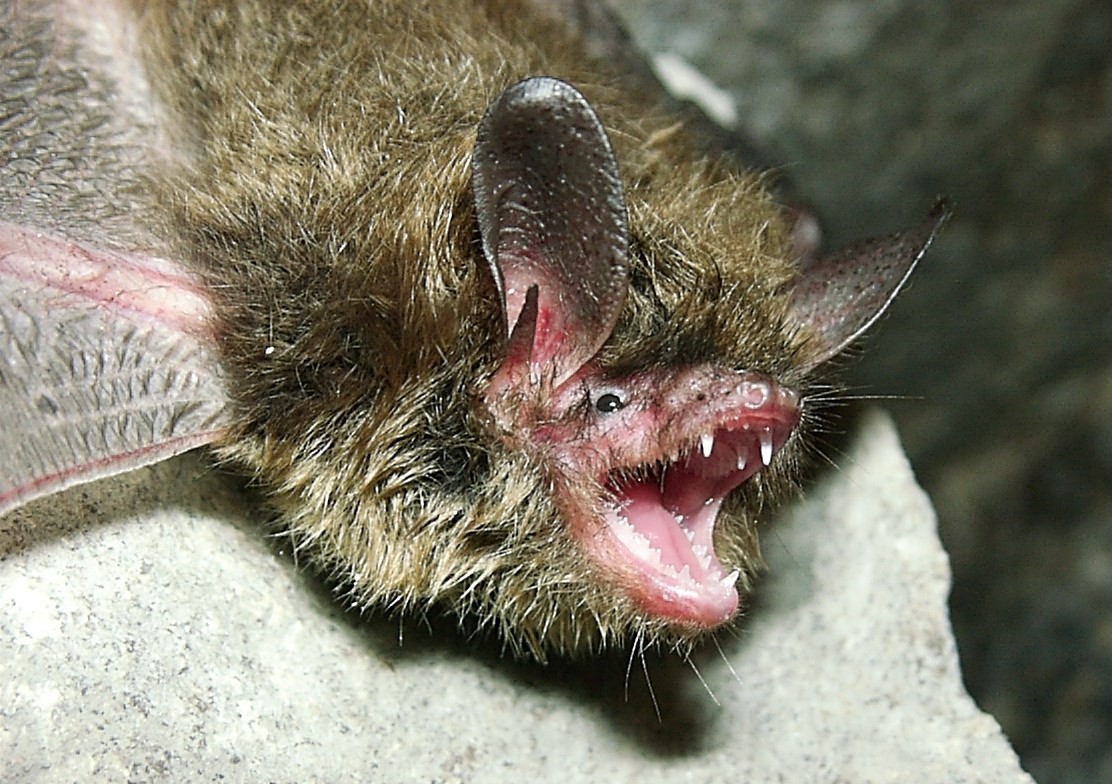Northern long-eared bat
A species of Mouse-eared bats, Also known as Northern long-eared myotis Scientific name : Myotis septentrionalis Genus : Mouse-eared bats
Northern long-eared bat, A species of Mouse-eared bats
Also known as:
Northern long-eared myotis
Botanical name: Myotis septentrionalis
Genus: Mouse-eared bats
Content
Description General Info
 Photo By U.S. Fish and Wildlife Service Headquarters , used under CC-BY-2.0 /Cropped and compressed from original
Photo By U.S. Fish and Wildlife Service Headquarters , used under CC-BY-2.0 /Cropped and compressed from original Description
The northern long-eared bat is a small bat, measuring an average of 8.6 cm (3.4 in) in total length, including a tail about 4 cm (1.6 in) long. Adults weigh between 5 and 8 g (0.18 and 0.28 oz). The fur and wing membranes are light brown in color, and the bat lacks the dark shoulder spots found in the closely related, and otherwise similar Keen's myotis. Compared to other Myotis species, these bats have long ears with a relatively long, pointed tragus; when folded forwards the ears extend well past the nose. They also have a longer tail and larger wing area than most comparably sized Myotis bats, giving them increased maneuvrability during slow flight. 
Size
8 - 9 cm
Life Expectancy
18 years
Nest Placement
Building
Feeding Habits
Northern long-eared bat primarily consumes a diet of moths, beetles, flies, and various other insects. It utilizes echolocation to hunt prey during flight at dusk and dawn, exhibiting a high degree of aerial agility. This species has evolved particular auditory adaptations to locate insects in low-light conditions.
Habitat
Forested habitats, especially boreal forests, hardwood trees during the summer 
Dite type
Insectivorous
General Info
Feeding Habits
Bird food type
Behavior
Northern long-eared bat is primarily a solitary species known for its crepuscular foraging habit, often feeding on small flying insects. Notably, it exhibits a unique behavior of hibernating in cold habitats during winter. Despite being solitary, this species shows cooperation, as multiple individuals often roost together in cavities or caves.
Distribution Area
Northern long-eared bats are found through much of the eastern half of the United States and Canada from Manitoba and Newfoundland in the north to North Carolina and Alabama in the south. They're also found, but more rarely, in western parts of Canada, sometimes as far as the western borders of British Columbia and Yukon. They are found primarily in forested habitats, especially boreal forests, since they typically roost in hardwood trees during the summer. 
Species Status
The northern long-eared bat is predominantly threatened by white-nose syndrome, especially in the northeast portion of its geographic range where the population has decreased by 99%. Due to white-nose syndrome the Northern long-eared bat was considered threatened by the USFWS. This species has been recommended by the United States Fish and Wildlife Service for listing under section 4(d) of the Endangered Species Act. An oversight field hearing was held before the United States House Committee on Natural Resources in September 2014. A final decision was published in the Federal Register, listing the species as Threatened effective 30 days from the date of the publication (starting May 4, 2015). The Elroy-Sparta Bike Trail tunnels in West Central Wisconsin are closed for the season by the beginning of November, using the doors that the railroad added to prevent storm damage. The debate on when to close the tunnel caused a conflict between the U.S. Fish and Wildlife Service and the organizers of the Rails to Trails Marathon. The northern long-eared bat hibernates in Tunnel Number three. The Rails to Trails Marathon, a Boston Marathon qualifier, moved their event date to earlier in October from November in 2017 to accommodate an earlier tunnel closing than the original November 15 date. 

 Photo By U.S. Fish and Wildlife Service Headquarters , used under CC-BY-2.0 /Cropped and compressed from original
Photo By U.S. Fish and Wildlife Service Headquarters , used under CC-BY-2.0 /Cropped and compressed from original Scientific Classification
Phylum
Chordates Class
Mammals Order
Bats Family
Evening birds Genus
Mouse-eared bats Species
Northern long-eared bat